Analysis of Financial Principles and Costing for CMT Ltd Report
VerifiedAdded on 2023/03/30
|11
|824
|128
Report
AI Summary
This report, prepared for CMT Ltd, a textile manufacturing company, addresses the application of financial principles and costing methods. It begins by comparing marginal and absorption costing, outlining their differences and suitability for CMT Ltd's startup phase. The report then delves into Activity-Based Costing (ABC), detailing its design stages, comparing it with traditional costing, and highlighting its advantages. Furthermore, it analyzes a budget performance report, identifying variances and recommending cost reduction strategies, specifically targeting labor and material costs through automation and supplier management. The report concludes by emphasizing the importance of balancing cost reduction with employee morale and product quality.
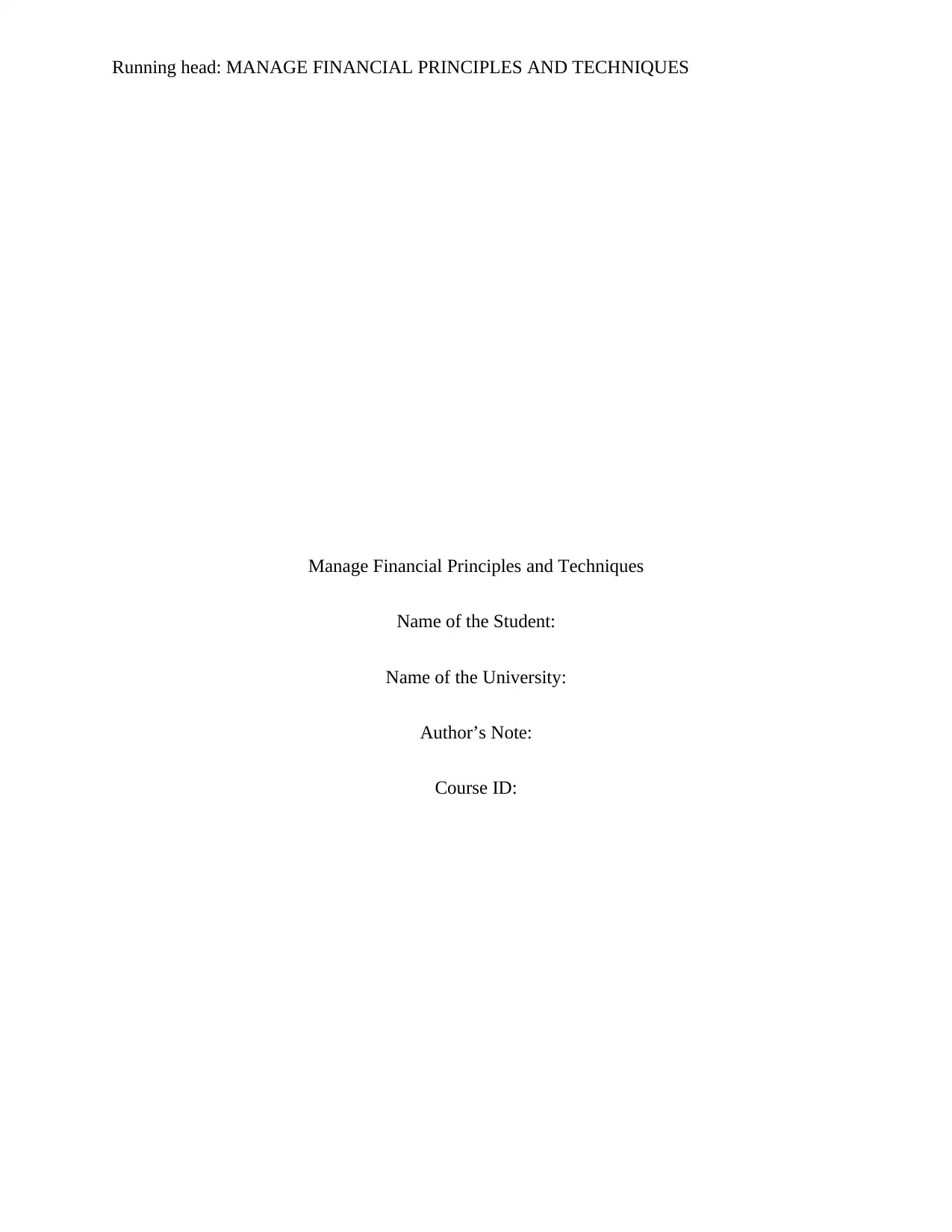
Running head: MANAGE FINANCIAL PRINCIPLES AND TECHNIQUES
Manage Financial Principles and Techniques
Name of the Student:
Name of the University:
Author’s Note:
Course ID:
Manage Financial Principles and Techniques
Name of the Student:
Name of the University:
Author’s Note:
Course ID:
Paraphrase This Document
Need a fresh take? Get an instant paraphrase of this document with our AI Paraphraser
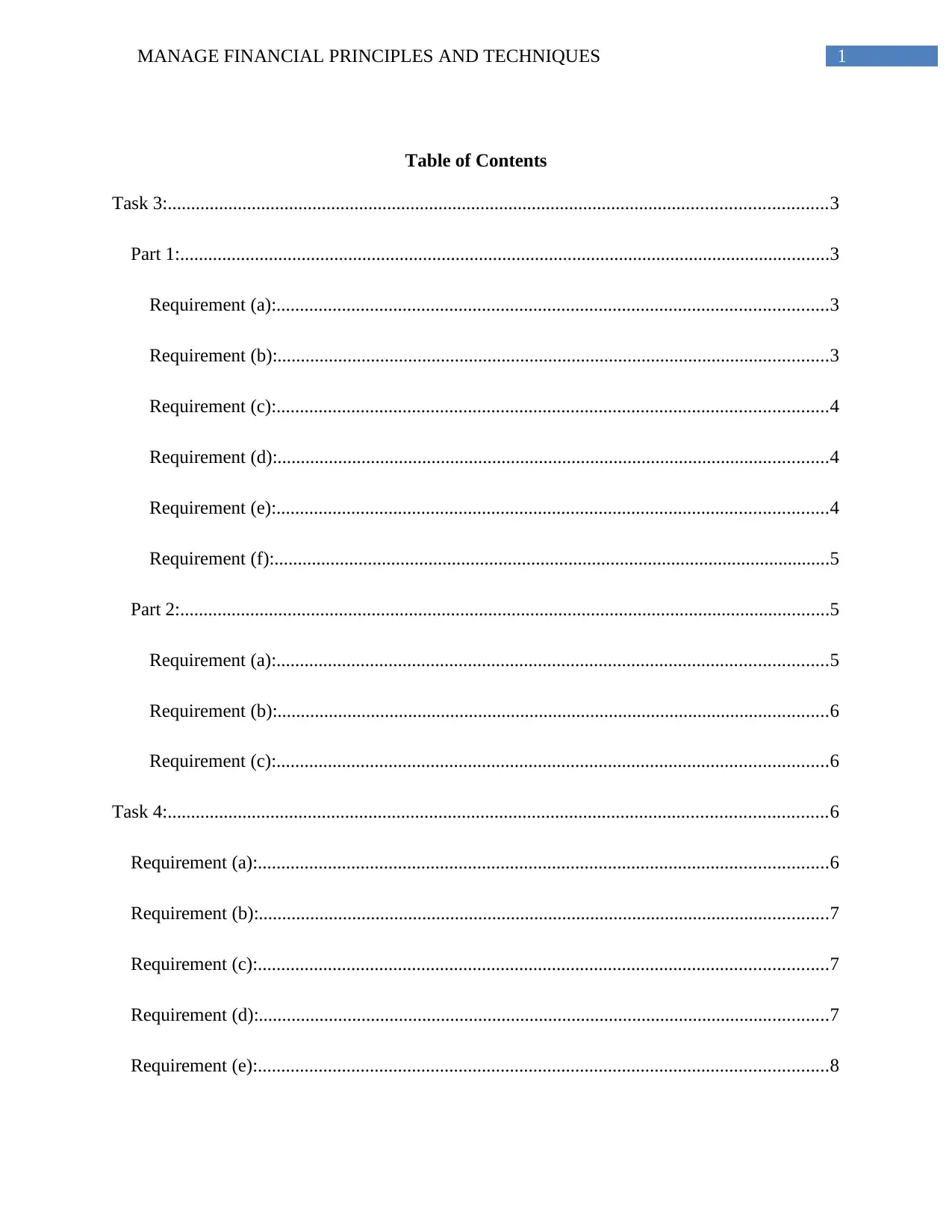
1MANAGE FINANCIAL PRINCIPLES AND TECHNIQUES
Table of Contents
Task 3:.............................................................................................................................................3
Part 1:...........................................................................................................................................3
Requirement (a):......................................................................................................................3
Requirement (b):......................................................................................................................3
Requirement (c):......................................................................................................................4
Requirement (d):......................................................................................................................4
Requirement (e):......................................................................................................................4
Requirement (f):.......................................................................................................................5
Part 2:...........................................................................................................................................5
Requirement (a):......................................................................................................................5
Requirement (b):......................................................................................................................6
Requirement (c):......................................................................................................................6
Task 4:.............................................................................................................................................6
Requirement (a):..........................................................................................................................6
Requirement (b):..........................................................................................................................7
Requirement (c):..........................................................................................................................7
Requirement (d):..........................................................................................................................7
Requirement (e):..........................................................................................................................8
Table of Contents
Task 3:.............................................................................................................................................3
Part 1:...........................................................................................................................................3
Requirement (a):......................................................................................................................3
Requirement (b):......................................................................................................................3
Requirement (c):......................................................................................................................4
Requirement (d):......................................................................................................................4
Requirement (e):......................................................................................................................4
Requirement (f):.......................................................................................................................5
Part 2:...........................................................................................................................................5
Requirement (a):......................................................................................................................5
Requirement (b):......................................................................................................................6
Requirement (c):......................................................................................................................6
Task 4:.............................................................................................................................................6
Requirement (a):..........................................................................................................................6
Requirement (b):..........................................................................................................................7
Requirement (c):..........................................................................................................................7
Requirement (d):..........................................................................................................................7
Requirement (e):..........................................................................................................................8

2MANAGE FINANCIAL PRINCIPLES AND TECHNIQUES
Requirements (f) and (g):.............................................................................................................8
Requirement (h):..........................................................................................................................8
References:....................................................................................................................................10
Requirements (f) and (g):.............................................................................................................8
Requirement (h):..........................................................................................................................8
References:....................................................................................................................................10
⊘ This is a preview!⊘
Do you want full access?
Subscribe today to unlock all pages.

Trusted by 1+ million students worldwide
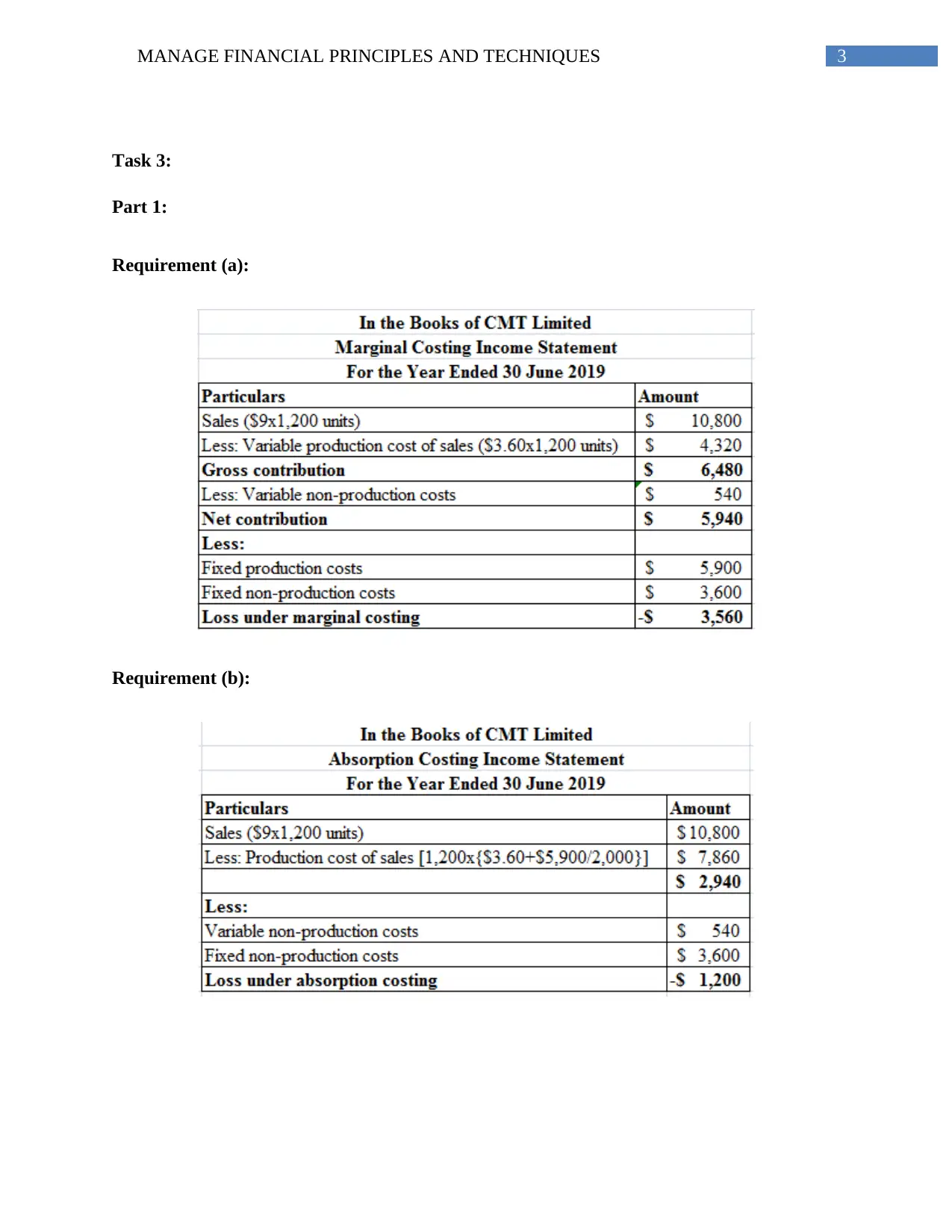
3MANAGE FINANCIAL PRINCIPLES AND TECHNIQUES
Task 3:
Part 1:
Requirement (a):
Requirement (b):
Task 3:
Part 1:
Requirement (a):
Requirement (b):
Paraphrase This Document
Need a fresh take? Get an instant paraphrase of this document with our AI Paraphraser

4MANAGE FINANCIAL PRINCIPLES AND TECHNIQUES
Requirement (c):
Requirement (d):
Marginal costing is a method that assumes only variable costs as product costs and fixed
cost is assumed as periodic cost. On the other hand, absorption costing considers both fixed cost
and variable cost in calculating product cost (Beatty and Liao 2014). Moreover, profit is
calculated by using profit-volume ratio under marginal costing and in case of absorption costing,
the consideration of fixed cost in product cost minimises the overall profit. For CMT Limited, it
is a start-up organisation and hence, it would focus on contribution per unit and break-even point
for which marginal costing would be beneficial. Later on, it should switch to absorption costing
for better cost allocation and formulation of strategies.
Requirement (e):
The detailed breakdown of the line items is shown in the above tables.
Requirement (c):
Requirement (d):
Marginal costing is a method that assumes only variable costs as product costs and fixed
cost is assumed as periodic cost. On the other hand, absorption costing considers both fixed cost
and variable cost in calculating product cost (Beatty and Liao 2014). Moreover, profit is
calculated by using profit-volume ratio under marginal costing and in case of absorption costing,
the consideration of fixed cost in product cost minimises the overall profit. For CMT Limited, it
is a start-up organisation and hence, it would focus on contribution per unit and break-even point
for which marginal costing would be beneficial. Later on, it should switch to absorption costing
for better cost allocation and formulation of strategies.
Requirement (e):
The detailed breakdown of the line items is shown in the above tables.
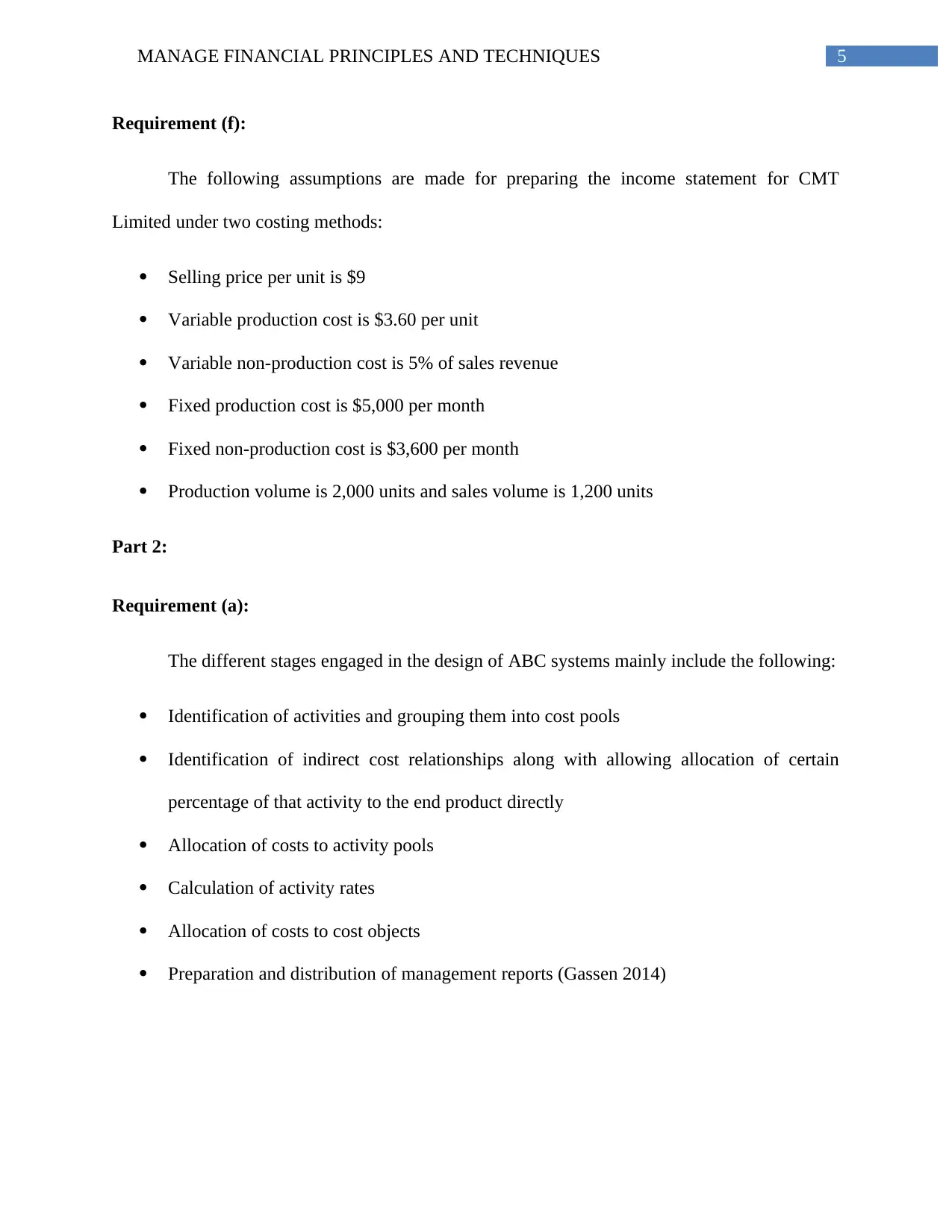
5MANAGE FINANCIAL PRINCIPLES AND TECHNIQUES
Requirement (f):
The following assumptions are made for preparing the income statement for CMT
Limited under two costing methods:
Selling price per unit is $9
Variable production cost is $3.60 per unit
Variable non-production cost is 5% of sales revenue
Fixed production cost is $5,000 per month
Fixed non-production cost is $3,600 per month
Production volume is 2,000 units and sales volume is 1,200 units
Part 2:
Requirement (a):
The different stages engaged in the design of ABC systems mainly include the following:
Identification of activities and grouping them into cost pools
Identification of indirect cost relationships along with allowing allocation of certain
percentage of that activity to the end product directly
Allocation of costs to activity pools
Calculation of activity rates
Allocation of costs to cost objects
Preparation and distribution of management reports (Gassen 2014)
Requirement (f):
The following assumptions are made for preparing the income statement for CMT
Limited under two costing methods:
Selling price per unit is $9
Variable production cost is $3.60 per unit
Variable non-production cost is 5% of sales revenue
Fixed production cost is $5,000 per month
Fixed non-production cost is $3,600 per month
Production volume is 2,000 units and sales volume is 1,200 units
Part 2:
Requirement (a):
The different stages engaged in the design of ABC systems mainly include the following:
Identification of activities and grouping them into cost pools
Identification of indirect cost relationships along with allowing allocation of certain
percentage of that activity to the end product directly
Allocation of costs to activity pools
Calculation of activity rates
Allocation of costs to cost objects
Preparation and distribution of management reports (Gassen 2014)
⊘ This is a preview!⊘
Do you want full access?
Subscribe today to unlock all pages.

Trusted by 1+ million students worldwide

6MANAGE FINANCIAL PRINCIPLES AND TECHNIQUES
Requirement (b):
Traditional costing is involved in using a single overhead pool and it is not able in
computing the actual cost. The object costs are allocated on random basis depending on labour or
machine hours. On the other hand, ABC system is involved in including identifiable product
parts or labours, while traditional costing gathers expenses, depreciation, salaries and others. In
the traditional costing system, the organisation ascertains the production cost after manufacturing
the products. In case of the ABC system, the product or cost value is ascertained based on pocket
range and customer feedback (Henderson et al., 2015).
Requirement (c):
ABC system is deemed to be accurate and as a result, it is preferred over the traditional
accounting system. The small targeted costs developed on activities are computed by using the
ABC system. The ABC system is considered to be beneficial, as it aids in the simplification of
the decision-making process and thus, the management concepts become clear and target-
focused. It assists in analysing performances and setting standards, which could assist the
managers to utilise information for comparison purposes.
Task 4:
Requirement (a):
Requirement (b):
Traditional costing is involved in using a single overhead pool and it is not able in
computing the actual cost. The object costs are allocated on random basis depending on labour or
machine hours. On the other hand, ABC system is involved in including identifiable product
parts or labours, while traditional costing gathers expenses, depreciation, salaries and others. In
the traditional costing system, the organisation ascertains the production cost after manufacturing
the products. In case of the ABC system, the product or cost value is ascertained based on pocket
range and customer feedback (Henderson et al., 2015).
Requirement (c):
ABC system is deemed to be accurate and as a result, it is preferred over the traditional
accounting system. The small targeted costs developed on activities are computed by using the
ABC system. The ABC system is considered to be beneficial, as it aids in the simplification of
the decision-making process and thus, the management concepts become clear and target-
focused. It assists in analysing performances and setting standards, which could assist the
managers to utilise information for comparison purposes.
Task 4:
Requirement (a):
Paraphrase This Document
Need a fresh take? Get an instant paraphrase of this document with our AI Paraphraser

7MANAGE FINANCIAL PRINCIPLES AND TECHNIQUES
Requirement (b):
Requirement (c):
Requirement (d):
Requirement (b):
Requirement (c):
Requirement (d):

8MANAGE FINANCIAL PRINCIPLES AND TECHNIQUES
Requirement (e):
Requirements (f) and (g):
From the above table, it could be seen that the organisation has managed to generate
higher sales by $5,000 compared to the budgeted sales, which is a favourable indicator. On the
other hand, the expenses like material costs, labour costs, plant running costs, production
overheads and selling and administration overheads are more than the budgeted figures due to
which there has been significant decline in profit by $12,450.
Requirement (h):
For minimising costs, the organisation needs to reduce mainly labour costs and material
costs by automating certain processes and finding new suppliers to obtain higher quality
Requirement (e):
Requirements (f) and (g):
From the above table, it could be seen that the organisation has managed to generate
higher sales by $5,000 compared to the budgeted sales, which is a favourable indicator. On the
other hand, the expenses like material costs, labour costs, plant running costs, production
overheads and selling and administration overheads are more than the budgeted figures due to
which there has been significant decline in profit by $12,450.
Requirement (h):
For minimising costs, the organisation needs to reduce mainly labour costs and material
costs by automating certain processes and finding new suppliers to obtain higher quality
⊘ This is a preview!⊘
Do you want full access?
Subscribe today to unlock all pages.

Trusted by 1+ million students worldwide

9MANAGE FINANCIAL PRINCIPLES AND TECHNIQUES
materials at cheaper prices (Hoyle, Schaefer and Doupnik 2015). However, automation of few
process might result in staff reduction that might have adverse impact on employee morale and
obtaining materials at lower costs might lead to compromise in product quality.
materials at cheaper prices (Hoyle, Schaefer and Doupnik 2015). However, automation of few
process might result in staff reduction that might have adverse impact on employee morale and
obtaining materials at lower costs might lead to compromise in product quality.
Paraphrase This Document
Need a fresh take? Get an instant paraphrase of this document with our AI Paraphraser
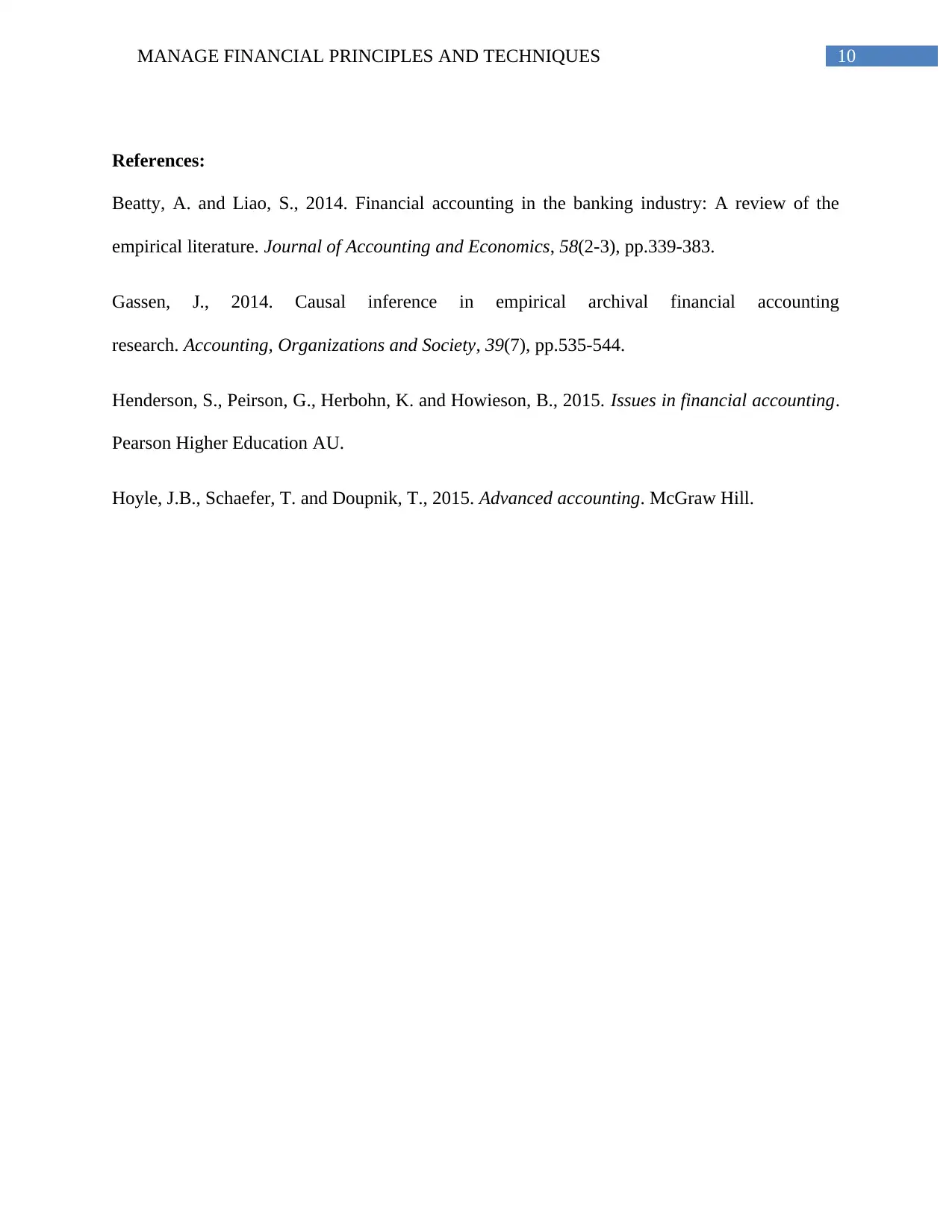
10MANAGE FINANCIAL PRINCIPLES AND TECHNIQUES
References:
Beatty, A. and Liao, S., 2014. Financial accounting in the banking industry: A review of the
empirical literature. Journal of Accounting and Economics, 58(2-3), pp.339-383.
Gassen, J., 2014. Causal inference in empirical archival financial accounting
research. Accounting, Organizations and Society, 39(7), pp.535-544.
Henderson, S., Peirson, G., Herbohn, K. and Howieson, B., 2015. Issues in financial accounting.
Pearson Higher Education AU.
Hoyle, J.B., Schaefer, T. and Doupnik, T., 2015. Advanced accounting. McGraw Hill.
References:
Beatty, A. and Liao, S., 2014. Financial accounting in the banking industry: A review of the
empirical literature. Journal of Accounting and Economics, 58(2-3), pp.339-383.
Gassen, J., 2014. Causal inference in empirical archival financial accounting
research. Accounting, Organizations and Society, 39(7), pp.535-544.
Henderson, S., Peirson, G., Herbohn, K. and Howieson, B., 2015. Issues in financial accounting.
Pearson Higher Education AU.
Hoyle, J.B., Schaefer, T. and Doupnik, T., 2015. Advanced accounting. McGraw Hill.
1 out of 11
Related Documents
Your All-in-One AI-Powered Toolkit for Academic Success.
+13062052269
info@desklib.com
Available 24*7 on WhatsApp / Email
![[object Object]](/_next/static/media/star-bottom.7253800d.svg)
Unlock your academic potential
Copyright © 2020–2025 A2Z Services. All Rights Reserved. Developed and managed by ZUCOL.




